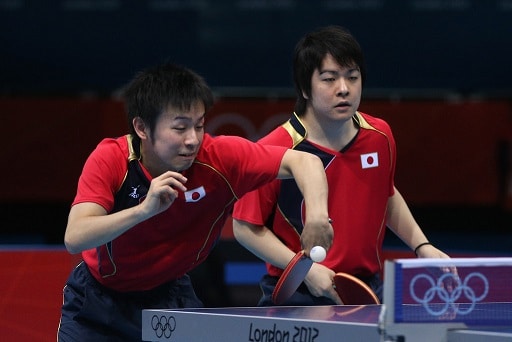Many players assume their serves are perfectly legal as long as most opponents do not complain about them. You would be wise not to make that assumption. Since becoming a club level umpire, my awareness of the legality of serves has been heightened.
I have noticed that a great majority of players, at all skill levels, have at least one flaw in how they serve the ball, particularly regarding the tossing hand. Here is a checklist to use to see if your serves have the proper “hands-on” approach:

Your hand before the toss;
– Is it above the table surface up until just after the toss?
– Is it behind the end line or the extended end line?
– Is it stationary for a second or two before projecting the ball upward?
– Is the ball resting motionless in your palm – not the fingers?
– Is your hand flat enough; no excessive cupping around the ball?
Your hand during the toss
- Are you tossing the ball near vertically enough – not backward, nor forwards, nor sideways? (Don’t expect an umpire to allow a toss beyond 10 degrees of vertical.)
- Are you getting an actual separation between the ball and your palm, which at a minimum, is 6 inches – not simply lifting the ball with little or no separation?
After the toss
- Do you immediately remove your tossing hand so that it is no longer between your body and the net? This most recent stipulation to the service rules was added to guarantee that your opponent can see the ball at the critical moment it is struck.
- Do you wait until the descent of the ball from your toss before striking it with the racket – not during the rise of the toss, nor at the top of the toss?
Finally
- Perhaps the most important item included in the service rules is that you must serve in such a way that if an umpire were present, he/she would not doubt that your serves are in complete compliance with what constitutes good service.
Please be aware that if an umpire has any concerns regarding your serve’s legality, he/she is under no obligation to warn you first. The responsible action of the referee concerning the serve is often abrupt. He/She must call “fault” and award the receiver a point whenever the server violates a service rule.
I strongly urge all of you, particularly tournament players, to have at least one other player observe your serves to see whether you conform to all of the items in the checklist above. Remember, the rules are meant to ensure that no contestant gains an unfair advantage.
I do not doubt that most of us intend to play honestly and resolutely and therefore hope you will accept this advice in the spirit given.
Service Receive Secrets From Japan

Koki Niwa executing the “Chiquita” Receive. Photo source: Zimbio.com
When I was in Japan earlier this year for table tennis training, I picked up the March issue of “World Table Tennis” magazine. There are many articles in it regarding service and service return, so I thought I’d get to sharpening up my Japanese translation skills and sharing some of the insights with you all.
This particular article is about the Chiquita receive, also known as the “tikita,” banana backhand or backhand sidespin flick, and is most famously used by current world champion Zhang Jike. First, it talks about the principle behind the Chiquita:
(Text from me is in bold, the translated text is in italics)
When hitting a spinning ball, after which the ball you contact can change how much effect the spin has on your racket…Every kind of spin has an axis. Sections of the ball far from the axis (called the equator) have a larger circumference, so they move faster. Conversely, sections of the ball close to the axis have a lower speed of spin. So, when considering the effect of the spin on your racket, remember that it will be more significant close to the equator and smaller closer to the axis.
With this “axis grabbing receive,” you will contact the ball close to the axis and make the effect of your opponent’s spin smaller, so it is called a ball controlling technique. In recent years, the popular technique known as the “Chiquita” is one such technique that makes use of this principle.

Translated text from graphic: Far from the axis (near the equator), the spin is strong, so it’s easy to have an effect!

Translated text from the graphic: Near the axis, there is a weak spin, so it’s difficult to affect. Grab the ball here!
Interestingly, although the article does not explicitly say so, the graphic above shows a ball with a sidespin, with the axis at the top, so you should be more inclined to try topspin against sidespin serves to take advantage of this principle.
On the next page, it goes on to explain why the Chiquita is better than a regular backhand drive against backspin.
The Chiquita is a type of backhand drive used against balls over the table. It allows you to add sidespin while attacking the ball. When trying to add to the ball’s spin, “contact the left side of the ball (for right-handers)” is often given a tip. If the service is backspin, you will certainly be contacting the axis by doing this.
When hitting a backspin ball near its equator, as you would for a regular backhand drive, you will contact a faster spinning part of the ball and, consequently, if you don’t have enough swing speed, lifting the ball over the net will be much more difficult. However, with the Chiquita, by contacting the axis on the ball’s left side, the spin’s effect will be much smaller and, therefore, relatively easy to lift over the net.
This technique is highly effective against backspin and other types of unexpected spins your opponent may serve, so it is good to try to use it against those as well.

Translated text from graphic: Chiquita – grabs the ball’s axis so even against backspin it’s easy to lift the ball.
Over-the-table BD (Backhand drive) – grab’s the ball’s equator so if you don’t have enough swing speed, you’ll put the ball in the net.


These images show Ryusuke Sakamoto (Latest WR: 224 in December 2011) demonstrating the Chiquita against backspin (in Japanese, image progression goes from right to left). Notice how:
– his upper arm does not move,
– his forearm is almost perpendicular and;
– at contact, his wrist is slightly bent to come slightly on the top side of the ball.
Well, I hope this has been helpful because it was tiring to translate!
All graphics and original Japanese text from Issue 190 (March 2013) of World Table Tennis (world-tt.com)
Stiga STS410Q Table Tennis Table

Warren Davies
Hi, I’m Warren Davies, a table tennis addict who loves sharing tips, reviews, and everything you need to level up your game. I’ve spent years playing, testing gear, and geeking out over the sport, and I’m here to make things simple and fun for players of all levels. When I’m not writing, you’ll probably find me perfecting my forehand or trying out the latest paddle.








